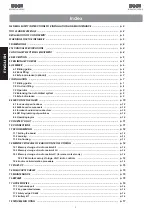
830873-0001 REV 02/20/2023
©Copyright 2023 Wayne Dalton, a division of Overhead Door Corporation
18
• On steel walls the hood flange must be fastened to each connection point by
drilling holes through the hood flange and into wall.
• Attach the hood to the hood band on headplate bracket by drilling a 7/32”
hole through the hood and band. Then secure hood with 1/4” tapping screw,
maximum length 7/16”. Longer screws can prevent door closing. Use four
screws per bracket. See Figure 27.
• Install hood support at each hood splice if required.
23. INSTALLATION FOR HOOD SEGMENTS AND HOOD SUPPORTS
• Snap a chalk line across the header at the top of headplate brackets.
• Measure the length of the top flange on the left hand hood segment.
• Position top of internal hood support just under chalk line with right hand
edge of hood support at a distance from the headplate that is equal to
length of top flange on LH hood segment; and fasten hood support to wall.
• Place the LH hood segment of the headplate hood bands and on hood
support. The distance between the flame baffle and the hood support
should be one inch or less. Flame baffle must be free to drop without
interference with hood support. Models 800F and 800FE will have no flame
baffle.
• Fasten hood flange to wall with fasteners appropriate for wall construction.
• Place second hood segment onto headplate hood bands and hood
support and fasten hood flange to wall with fasteners appropriate for wall
construction.
• Attach the hood to hood bands and hood support with 1/4” dia. by 3/8” long
tapping screws; longer screws may prevent door closure. Use four screws on
each hood band and support. See Figure 27.
21. CHECK THE FOLLOWING ITEMS BEFORE HOOD INSTALLATION
• Verify through entire travel of the door that endlocks on each side of
the curtain are not rubbing on the headplate brackets. Operate the
door several times in order to make this determination.
• Verify that the bottom bar is level in full down and full up positions
and that the curtain is not binding on the guides.
• If curtain is level at bottom and not level at top, put shims between
curtain and barrel on the low side.
• The guides may be lubricated with paste wax or silicone spray. DO
NOT USE GREASE.
• Verify good mechanical connection and tightness of all fasteners, i.e.,
guides, headplates, set screws and roller chain links.
• Apply all warning labels in the appropriate locations before leaving
the installation site.
• Check the area for any extra parts, and be sure these were not
omitted in the installation process.
• Re-check all bolted connections to verify all are securely tightened.
• Clean up the area and make sure it is secure, with the handle
engaged with the pin provided.
• If the building owner or facility manager is unfamiliar with the
product, demonstrate the operation of the door and any optional
equipment before leaving the job site. Point out the importance of
Pad- Locking the release handle to avoid possible tampering.
• Have the customer or his representative sign off on the installation
provided in the hardware bag. Keep a completed copy of this form
in your maintenance files. Exchange all documentation and keys to
locks at this time.
• Be sure to report (in writing) to the factory any complaints or
recommendations the customer may register at the completion of
the installation that may have a bearing on future designs.
•
IMPORTANT:
WARNING LABEL MUST BE APPLIED TO OPERATED
SIDE OF THE ROLLING DOOR, ON THE GUIDE, 5 FEET ABOVE THE
FLOOR.
22. HOOD INSTALLATION FOR ONE PIECE HOOD
• Hood flange must be securely fastened to the wall.
• On masonry walls use masonry fasteners through each hole in the
hood flange.
Face mounted
Bottom Flange
Notch for bolt
(as required)
Final Door Install (continued)
Figure 27








































